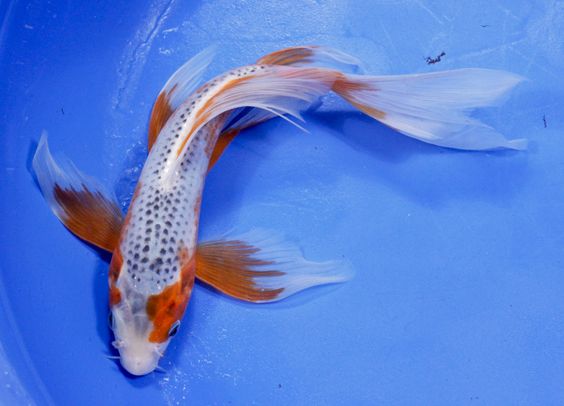Asagi koi fish, with their mesmerizing blend of blue and white, are a captivating sight in any pond. This article delves into the world of Asagi koi, exploring their unique characteristics, history, and the factors that contribute to their stunning beauty. From the origins of their distinctive coloration to the nuances of their patterns, we’ll uncover the secrets behind these elegant aquatic gems. Let’s find out with Love My Koi!
The Asagi Koi: A Tale of Blue and White Elegance
Asagi koi, meaning “morning dew,” are a captivating variety of koi known for their striking blue and white coloration. Their bodies are adorned with a deep blue base color, often described as “azure” or “indigo,” which is contrasted by a crisp white “sashi” (pattern) that extends from their head to their tail. This combination creates a mesmerizing visual effect, reminiscent of a clear sky reflected in a calm pond.

1. The Origins of Asagi Koi: A Legacy of Selective Breeding
Asagi koi are a product of centuries of selective breeding in Japan. Breeders meticulously selected koi with desirable blue and white patterns, gradually refining the characteristics that define this variety. The result is a fish that embodies the beauty and artistry of Japanese koi breeding.
2. The Distinctive Features of Asagi Koi: A Symphony of Color and Pattern
Asagi koi are characterized by their deep blue base color, often described as “azure” or “indigo,” which is contrasted by a crisp white “sashi” (pattern) that extends from their head to their tail. The “sashi” can vary in width and intensity, creating a range of patterns that add to the Asagi’s visual appeal.
a. The “Sashi”: A Signature Pattern
The “sashi” is the defining feature of Asagi koi. It is a white pattern that runs along the back and sides of the fish, starting from the head and extending to the tail. The “sashi” can be wide or narrow, dense or sparse, creating a variety of patterns that add to the Asagi’s visual appeal.
b. The “Hi”: A Splash of Red
Some Asagi koi also have a red “hi” (spot) on their head. The “hi” can be small or large, round or elongated, and can be located on the top of the head, the nose, or the cheek.
c. The “Ginrin”: A Shimmering Effect
Some Asagi koi also have “ginrin” (silver scales), which give the fish a shimmering effect. Ginrin scales are larger and more reflective than regular scales, creating a dazzling display of light and color.
3. The Appeal of Asagi Koi: A Timeless Beauty
Asagi koi are highly prized by collectors and enthusiasts for their elegant appearance and the captivating interplay of their blue and white colors. Their distinctive patterns and the subtle variations in their coloration make them a fascinating and sought-after variety.
The Care and Maintenance of Asagi Koi: Creating a Thriving Environment
Asagi koi, like all koi, require a well-maintained pond to thrive. Providing the right environment, including water quality, diet, and protection from predators, is essential for their health and longevity.
1. Water Quality: The Foundation of Koi Health
Asagi koi are sensitive to fluctuations in water parameters, such as pH, ammonia, nitrite, and nitrate. Maintaining optimal water quality is essential for their survival and longevity. Regular water changes, proper filtration, and monitoring of water parameters are crucial.
2. Diet: Nourishing Your Asagi Koi
Asagi koi are omnivores and require a balanced diet that includes both plant and animal matter. High-quality koi food pellets, supplemented with occasional treats like worms, shrimp, or vegetables, provide the essential nutrients for their growth and well-being.
3. Protection: Keeping Your Asagi Koi Safe
Asagi koi are susceptible to predators, such as birds, raccoons, and snakes. It is important to protect your koi from predators by using a fine mesh net or covering the pond with netting. You can also install a pond skimmer to remove debris and insects that attract predators.
Frequently Asked Questions About Asagi Koi
1. What are the different types of Asagi koi?
There are several types of Asagi koi, including the standard Asagi, the Ginrin Asagi, and the Doitsu Asagi. Each type has its own unique characteristics and patterns.
2. How much does an Asagi koi cost?
The price of an Asagi koi can vary widely depending on its size, age, quality, and pattern. Some Asagi koi can fetch thousands or even millions of dollars.
3. What are the best ways to care for Asagi koi?
Asagi koi require a large pond with clean, oxygenated water. They also need a balanced diet and regular water changes. It is also important to protect them from predators.
4. Are Asagi koi good pets?
Asagi koi can make excellent pets, but they require a significant commitment of time and resources. They need a large pond, regular maintenance, and a balanced diet.
5. Where can I buy Asagi koi?
You can buy Asagi koi from koi breeders, pet stores, and online retailers. It is important to choose a reputable source to ensure that you are getting healthy and well-bred koi.
Conclusion: A Journey into the World of Asagi Koi
Asagi koi, with their captivating blend of blue and white, are a testament to the beauty and artistry of Japanese koi breeding. Their elegant appearance, distinctive patterns, and the subtle variations in their coloration make them a fascinating and sought-after variety. Whether you are a seasoned koi enthusiast or a newcomer to the world of these aquatic gems, Asagi koi offer a captivating experience, a symphony of color and elegance that will grace any pond.

Related Posts
Kikusui Koi Fish: A Symphony of Color and Elegance
Red Koi Fish: A Vibrant Splash of Color in Your Pond
Yamabuki Ogon Koi: A Golden Treasure in Your Pond